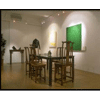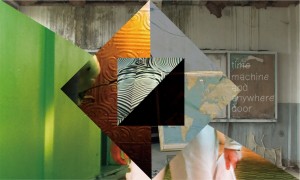 |
IT Park Gallery & Photo Studio
41,
2/F Yi Tong Street
Taipei, Taiwan map *
tel: +886 2 25 07 72 43
fax: +886 2 25 07 11 49
send email
website
|

Enlarge
|
| Time Machine and Anywhere Door
|
|
| by IT Park Gallery & Photo Studio
Location: IT Park, Taipei
Artist(s): CHEN Chieh Jen, Aerial Waller MARK, Claire HOOPER, Shang Lin WU, Joseph WALSH
Date: 17 Jul - 14 Aug 2010
The malleability of time and space is central to Time Machine and Anywhere Door, bringing together artists who in various ways transform reality through meditative, surreal and occasionally absurdist installations. This inter-generational group of five artists from the UK and Taiwan, employ the moving image as a means to transport the viewer to another place or time – real or imagined, past or future — wilfully creating slippages between cultural motifs, histories and fictions. They exploit the medium’s portability and the ease with which wide-ranging references can be brought together, demonstrated by the artists’ use of found footage, appropriated imagery and visual styles that together provide a cross-section of global cultural activity.
Conscious of the ever-increasing global dissemination of localised visual information, from films and television programmes to resources such as youtube and social networking sites, Time Machine and Anywhere Door takes its name from a popular Japanese Manga cartoon, whose robot-cat Doraemon can teleport to ‘anywhere’, leading to fantastical journeys to outer worlds in the past and future to solve the problems of his human friend. These essentially moralising tales of time-travel are embedded in international folklore and endlessly reoccur across cultural boundaries. For the generation growing up with sci-fi TV shows, from the Asian animation Doraemon through to US dramas Quantum Leap or Back to the Future, the story remains essentially the same although the language and style are culturally specific.
The ‘fourth dimension’ is characterised in Doraemon as a special pocket, echoing the use of pre-CGI props and costumes by the three UK-based artists in the exhibition, whose work is permeated with an otherworldly surrealism. In her video The Blessing (2007), originally conceived as a site specific, 12channel immersive installation, Claire Hooper creates a hypnotic and spatial narrative evoking religious ‘rapture’ as described by St. Teresa of Avila. A higher purgatorial plane is represented as a hallucinatory dream with outer space-exposing kaleidoscopes and retro-futurist club interiors populated by meditative figures bathed in the glow of pink and orange lights. Combining the hand-made aesthetic of b-movies and old television shows to create an analogue nostalgia with the contemporary ocular overtones of digital technology, Hooper has sited The Blessing as a place free of time and space, a liminal zone of the imagination and a place with which to access parallel worlds or realities. Cult genre films and science fiction also pervade the numerous cinematic references in Mark Aerial Waller’s video The Flipside of Darkness (2007), the second episode in his cycle of films Resistance Domination Secret. Structured around the Greek epic Orestia by Aeschylus, the film is set in Poland with actors accents belying their projected ancestry; its eccentric formality of style and haracterisation disrupts eras and time ones, appropriating a myriad of cultural references along the way, accompanied by a playful electro soundtrack by youtube favourite Romvelope. Aerial Waller’s practice interrogates the limits of cinema and the slippage between virtual and real space, often appropriating and re-presenting movies and archive footage, creating films, performances and sculptural installations that sneak through perceived cultural and national barriers and mine a rich variety of sources from Greek mythology to early French cinema, psychedelia and artists’ film.
Joseph Walsh’s video The Work Ahead of Us (2007) more directly references industrial cinema by re-staging a scene from Stanley Kubrick’s The Shining, replacing the props with Oriental iconography and characters with stereotypical Asian movie personas – a Chinese man chopping vegetables and a lone, clocked ninja. The clash of western and eastern cinematic styles and allusions to specific cult movies, as well as the unexpected roles and behaviour of the characters all have a disorientating and ambiguous effect on time and location. Walsh’s use of obsolete VHS technology compounds the confusion – the heightened colour and analogue characteristics deliberately remain at odds with the crisp digital images of contemporary film and permit indeterminate temporal interpretations.Chen Chien-Jen’s references also span an international cultural network of art and cinema, but the quiet delivery and political subject matter focus on the traumatic histories of Taiwan itself, from warfare to industrial decay. The Route (2006) was originally commissioned for the Liverpool Biennial in 2006 and investigates the rich material surrounding the 1995 dockworkers strike and the response by the international shipping community in California, Vancouver and Japan who refused the docking of the ‘Neptune Jade’, a ship crewed by Merseyside strike breakers. Eventually the ship docked at Port of Kaohsiung, Taiwan where it was sold off and broken up. Chien-Jen splices together archival footage of these Liverpool strikes with contemporary images of a dockers protest at Kaohsiung, fusing the two territories in a lyrical film that explores the similarities of international industrial experience by gently slipping back and forward through time and place.
Wu Shang Lin’s Space of Remembrance (2008) also emphasises common human experience using a more literal, meditative approach to the representation of the passing of time. Single shots pan throughout an abandoned school building, the vegetation encroaching through the windows and across the walls highlighting the beautiful, otherworldly process of decay and re-inhabitation by nature. Shang Lin’s use of the universal image of the classroom imbues the film with an immediate nostalgia and an emotive cinematic feel, the viewer can almost see the lessons being taught and hear the children playing in the familiar architecture. Although all the artworks in the exhibition reflect another space or time, the approaches to material and form create interesting counterpoints and changes in pace, from the frenetic use of pop references in Waller’s The Flipside of Darkness to the more formal meditations on history by Chien-Jen and Shang-Lin. Here, the Taiwanese artists provide the earthly reality to counter the otherworldly recollections of Waller, Hooper and Walsh whose British backgrounds perhaps leave the mark of a different aesthetic, one in which the propensity to interrogate fantasy, science fiction and the future is more vital than the past.
Curator Ada Kai-Ting Yang’s decision to show video by all five artists implies a political assessment of the mechanisms of contemporary cultural exchange and the dynamic portability and dissemination of cinema and digital media globally.As maps, nations and identities are endlessly disputed and countries close their borders, technology represents a positive future platform for global dialogue. Through artists’ film and video, cinema and the Internet, the moving image literally opens the door to another world.
--Victoria Brooks, 2010
|
|
|
|
|
